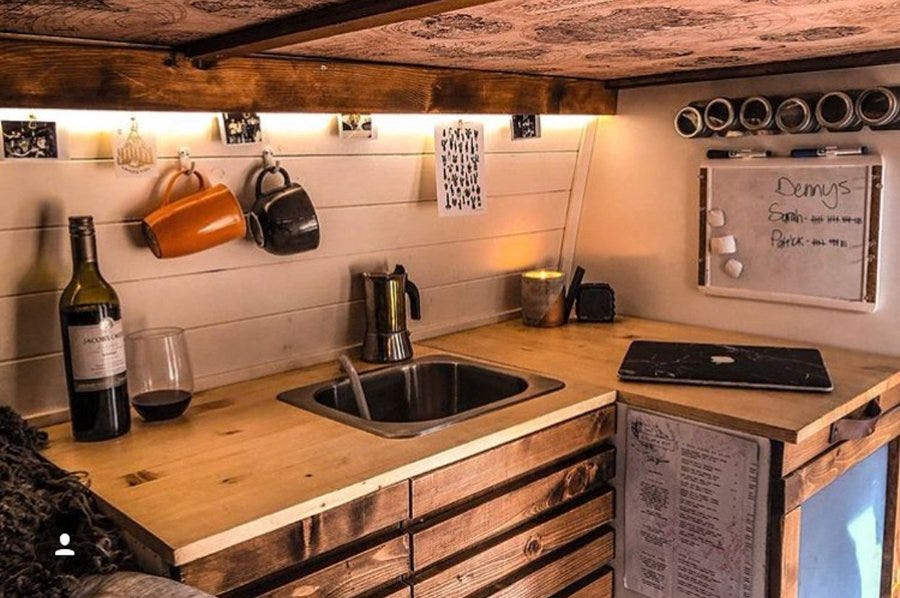The Sunday Read
Off-grid pitch on Dragon’s Den falls flat
A kitchen inside one of Paved to Pines’ converted, off-grid buses.
Paved to Pines, a company that converts school buses and vans into mobile, off-grid homes, failed to impress the investors when it appeared on the television show, Dragon’s Den, this past week.
Mitchell Rosko and his partner Steven Glass sought $200,000 worth of investment in their Saskatchewan-based firm. But the “dragons” took a hard pass, citing that since neither partner had put any of their own money into the business yet the dragons weren’t convinced that they should risk theirs either.
Rosko, quoted in a news report in St. Albert Today, said of the vehicles: “We pretty much turn them into houses on wheels, complete with solar panels, a completely off-grid power system and water system.”
The Dragon’s Den episode featuring the duo may be seen here
Academic looks to bolster energy security with off-grid solutions
While Paved to Pines might be out of the money, Xiaodong Liang is set to receive $120,000 annually for five years. No, the associate professor of electrical and computer engineering at the University of Saskatchewan didn’t pitch Dragon’s Den; rather, she is a new Canada Research Chair (CRC) in Technology Solutions for Energy Security in Remote, North and Indigenous Communities.
Liang’s CRC is the first of its kind in Canada, according to a news story in Yorkton This Week. The paper reports that the “research program is aimed at developing a new system of isolated microgrids, powered by renewable energy such as wind and solar.”
As well, the newspaper notes: “About 200,000 Canadians in 280 remote communities, along with many others in northern global areas, rely on off-grid power for electricity and heating, produced primarily by diesel generation. This is costly and fraught with environmental impacts such as greenhouse gases and diesel spills.”
Australia bush fires prompt investigation into large-scale, off-grid energy supply
Residents of Mallacoota flee last summer’s bush fires.
When devastating bush fires ripped through New South Wales in Australia last summer, the inferno took down 3,200 power poles in the state. The ABC News report doesn’t mention how many people that impacted, however, the point of their feature covers what a decade ago would have been an almost unthinkable premise: “energy networks, long maligned for passing on their exorbitant costs to consumers for building and maintaining power grids, are now helping customers go it alone.”
At this point, the Australian Energy Regulator is still trying to sort out what shape large-scale, off-grid utilities would take, and the kinds of regulations needed for them. But over in the town of Mallacoota, they have settled on a “large battery storage system that will begin discharging electricity if there is a disruption to the main power line,” according to ABC News. AusNet Services is building the system.
ABC notes that “Mallacoota will be able to sustain itself off the grid for up to three days, effectively operating as a large standalone power system.” AusNet Services is building a large battery storage system that will begin discharging electricity if there is a disruption to the main power line.
But Australian Energy Regulator chair Clare Savage told the network that the cost of battery storage was still holding back progress on larger standalone power systems. "The technology is changing rapidly, which is terrific, but we're still subject and vulnerable to days without sun or wind," Savage said.
A better battery may be on the way for off-grid use
The Karlsruhe Institute of Technology (KIT) in Germany is working to develop a new kind of hybrid energy storage system, combining lithium-ion and redox flow batteries. By merging the two types of batteries KIT hopes to create a better, longer-lasting battery.
According to a story in Innovative Origins, lithium-ion batteries are relatively inexpensive and compact, while redox flow batteries are reliable and long-lasting.
Nina Munzke from the KIT Battery Technical Center told Innovative Origins: “we want to use the electrolyte cells in the redox flow battery as thermal storage and thereby increase the overall efficiency of the system. This form of combined heat and power generation is a world premiere.”
The publication also reports that another project partner, the Germany-based Fraunhofer Institute for Chemical Technology “is working on an optimized electrolyte composition for the redox flow battery. This is a prerequisite for hearting applications.
“ The researchers point out that the electrolyte used in the battery does not have to be recycled, but can even be reused after the end of the battery system’s service life of about 20 years since it is not depleted during use.”


